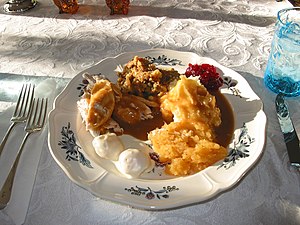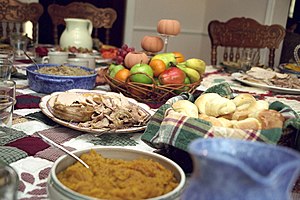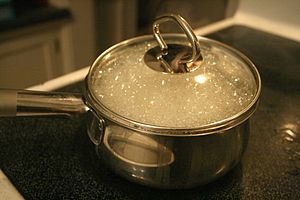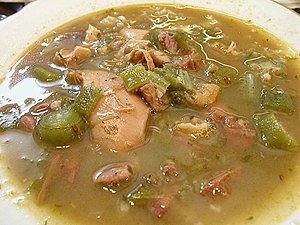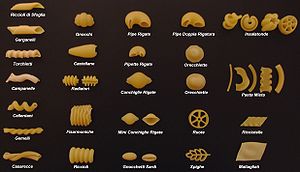 Image via WikipediaThere are two main categories of pasta used in Italian food: dried pasta and fresh pasta. Right now there are over 350 different shapes and varieties of dried pasta available for use in Italian cooking. Some varieties are common and others are specific to a certain regional area. The shapes used can range from the classic tubes and strands to butterflies or bowties and even unique shapes such as tennis rackets. Italian food is taken very seriously in Italy and by law all dried pasta is required to be made with pure durum semolina flour and water. This standard is adhered to by most pasta makers all over the world and only this type of dried pasta is used in good quality Italian food.
Image via WikipediaThere are two main categories of pasta used in Italian food: dried pasta and fresh pasta. Right now there are over 350 different shapes and varieties of dried pasta available for use in Italian cooking. Some varieties are common and others are specific to a certain regional area. The shapes used can range from the classic tubes and strands to butterflies or bowties and even unique shapes such as tennis rackets. Italian food is taken very seriously in Italy and by law all dried pasta is required to be made with pure durum semolina flour and water. This standard is adhered to by most pasta makers all over the world and only this type of dried pasta is used in good quality Italian food. One reason that Italian food in Italy tastes different than the Americanized Italian food is because pasta makers in Italy take more care in making quality pasta. Dried pasta is meant to hold onto the sauce with which it is being served. After all, Italian food wouldn't be Italian without the sauce. The pasta is made with ridges or into complex shapes in order to grab onto the sauce. These ridges are formed during a process known as extrusion. This is the step in pasta making where the pasta is forced out of a copper mold and then cut into the desired length before being dried. The copper molds are the key. They are expensive and likely to wear, but they make the best pasta. Unfortunately, most of the pasta used in American Italian food is made with steel molds that make the pasta too slick to hold onto the sauce. However, more and more pasta makers outside of Italy are beginning to use the copper molds in an effort to make better quality Italian food. The drying process also greatly affects the quality of the pasta and the resulting dish.
Pasta should be dried for a specific amount of time at a specific temperature depending on the variety. Pasta made in Italy is allowed to dry for long periods of time - up to fifty hours, and at relatively low temperatures. Companies outside of Italy typically dry their pasta at high temperatures in order to get it dried quicker. This method comes at a price and diminishes the quality of the pasta.
 Image via WikipediaThe other form of pasta used in Italian food is fresh pasta. All pasta actually starts out as fresh pasta but certain pasta recipes require that the pasta be eaten fresh and soft, not dried. Fresh pasta is often made with slightly different ingredients than dried pasta. In the northern parts of Italy fresh pasta is most often made with all-purpose flour and eggs. However, the southern parts of Italy make their fresh pasta with semolina and water. It should be noted that different recipes can call for different variations. These different recipes give a distinct flavor to the Italian food of different regions. Some types of pasta are meant just to be eaten fresh, while others are meant to be dried. There are also some types of pasta that can be eaten either fresh or dried, depending on what Italian food dish is being prepared.
Image via WikipediaThe other form of pasta used in Italian food is fresh pasta. All pasta actually starts out as fresh pasta but certain pasta recipes require that the pasta be eaten fresh and soft, not dried. Fresh pasta is often made with slightly different ingredients than dried pasta. In the northern parts of Italy fresh pasta is most often made with all-purpose flour and eggs. However, the southern parts of Italy make their fresh pasta with semolina and water. It should be noted that different recipes can call for different variations. These different recipes give a distinct flavor to the Italian food of different regions. Some types of pasta are meant just to be eaten fresh, while others are meant to be dried. There are also some types of pasta that can be eaten either fresh or dried, depending on what Italian food dish is being prepared.When a variation of pasta can be either dried or fresh it is sometimes argued that the fresh style is best. Making fresh pasta is a point of pride for many Italian households and is reflected in the quality of the Italian food that they prepare.

